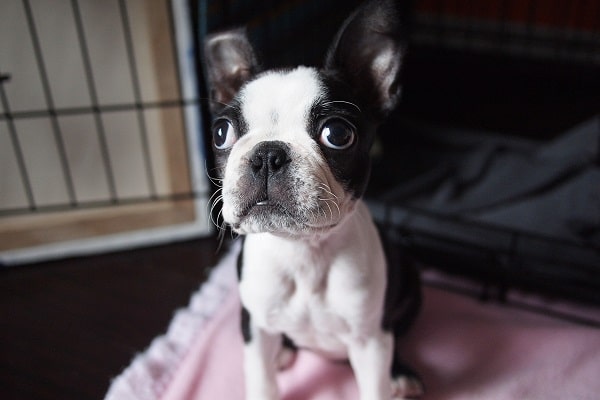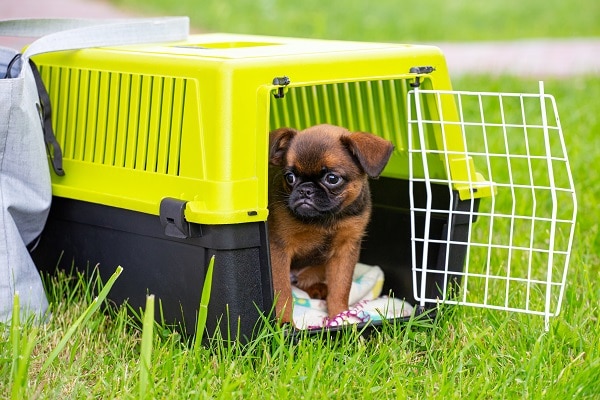You might be thinking about getting a puppy, but if you’re not sure how to train it or housebreak it, then this blog post is for you. Crate training is an excellent option for housebreaking puppies because it gives them a safe place they are comfortable. In this article, we’ll give you the basics of crate training and housebreaking your new pup. Follow these steps to ensure that your life doesn’t have too many accidents! Good luck.
Contents
- 1 The Benefits Of Crate Training A Dog
- 2 How To Crate Train A Puppy
- 3 Start When They Are Young
- 4 Introduce The Crate
- 5 Put Your Puppy In The Crate
- 6 Practice Closing The Door
- 7 Start Stepping Away For Short Periods Of Time
- 8 Work Your Way Up To Longer Periods
- 9 Some Tips
- 10 Make Sure They Have A Good View
- 11 Make The Crate A Positive Experience
- 12 Never Punish Your Dog For Crying In The Crate
- 13 Conclusion
The Benefits Of Crate Training A Dog

There are so many benefits to crate training a dog. When done correctly, it can housebreak your pup in a matter of weeks and make life much easier for both you and your furry friend. A crate provides a den-like atmosphere that dogs instinctively love. Dogs feel safe and secure in their crates, so they’re less likely to have accidents in the house.
The crate can also be a place for your pup to nap in or take a break from playing. If you have small children or other pets in the home, using a crate can help to keep your pup out of trouble. Crates are also suitable for dogs who like to chew things they’re not supposed to.
How To Crate Train A Puppy
Start When They Are Young

The best way to crate train a puppy is to start when they are very young, around eight to ten weeks old. Ideally, you should begin introducing your pup to the crate while they are still with their mom and siblings so that they can get used to it. If you have an older pup, don’t worry.
You can still get them used to a crate, but it may take longer than eight to ten weeks. You’ll want to start with a huge crate that will fit your pup when they are fully grown. This will give them plenty of space to move around and also help them feel comfortable in their new surroundings.
Introduce The Crate

If you use the same crate that you will keep your dog in when they are older, then introduce the look and smell of the crate before ever putting your dog inside. A few days before you intend to start crate training, keep the door open and fill it with your pup’s toys.
If your dog is older, give them a treat every time they look at or sniff the kennel. Then, give them treats and toys and let them play around it like it is just a big toy they can play with whenever they want. Be excited and happy as you do this, as it will help motivate your puppy. The idea is to make the crate a good thing before you ever put your pup inside of it.
Put Your Puppy In The Crate

Once your pup is comfortable with the sight and smell of the crate, it’s time to put them inside. Begin by putting them in for just a few minutes and gradually increasing their time in there.
If your pup starts to crying, whining, or barking, don’t let them out until they have stopped. This may take some time, but your puppy must learn that they will only be released from the crate when they are calm.
If you are using the crate for housebreaking purposes, make sure to take your pup outside immediately after letting them out of the crate. This will help them understand that going potty is always associated with being let out of the crate.
Practice Closing The Door

Once your pup gets comfortable and can play and sleep in the crate for at least 30 minutes, you can start to teach them that they can’t get out when the door is closed. If your dog starts crying or whining while you’re trying to close the door, resist the urge to open it up right away. Wait until they are quiet for a few minutes before letting them out.
If you have an older pup, you may have to leave the room or go outside and close the door so that they can’t follow you. The idea is to make sure that your pup understands that they can’t get out of the crate until you let them.
Start Stepping Away For Short Periods Of Time

Once your pup has grown comfortable with being in the crate, you can start to step away for short periods. Your dog may be confused when you first begin this process, as they will learn that being quiet and calm gets them out of the crate, but being noisy will only prolong their stay. If they are having a tantrum about it, sit outside or on the other side of a door so that they can’t see you.
Eventually, you’ll be able to leave the house for a few hours while your puppy remains in the crate without any problem. Ensure to give them plenty of water and bathroom breaks during this time, as they won’t be able to go to the bathroom in the crate.
Work Your Way Up To Longer Periods

When your pup can spend several hours in the crate without any significant complaints or accidents, you will be ready to try leaving them there all night. Take things very slowly for this process, as it can cause some anxiety and stress for both you and your dog if not done correctly.
As always, start by putting them in the crate for a short period and gradually increasing the time. If they seem to be doing well, you can try leaving them there for a few hours overnight. If they have any accidents, go back to leaving them in the crate for shorter periods until they can hold it for a more extended time.
Some Tips
Make Sure They Have A Good View

Many dogs get anxious when crated because there isn’t much to look at outside the crate door. If your puppy or dog can’t see you, it can feel like they have been abandoned and left alone. To avoid this feeling, make sure that your pup can see you through the side or front of the crate.
Make The Crate A Positive Experience

The key to successful crate training is making the crate a positive experience for your puppy. If your dog is afraid of the crate, it will be harder to get them to use it. Some easy ways to make the crate a good place include giving your pup a bed or blanket to curl up on, putting their food and water inside, and giving them plenty of toys.
You can also let your pup come and go from the crate as they please, but always make sure to close it up before you leave and let them out when they must go. If your pup feels afraid of the crate, this will help them get used to it faster than if it’s something they hate.
Never Punish Your Dog For Crying In The Crate

Suppose your pup is crying or barking while in the crate; it’s not because they hate it. It’s because they don’t like being away from you and want to come out. Don’t ever punish your pup for this by making them stay in longer. Instead, wait until your dog is quiet and then let them out.
Conclusion
In conclusion, crate training is a great way to train your pup and ensure that they have a safe place to go. It’s important to remember that every dog is different and will take an additional amount of time to crate train properly. Be patient and consistent with your puppy, and they will eventually learn that the crate is a safe and comfortable place for them to be.


